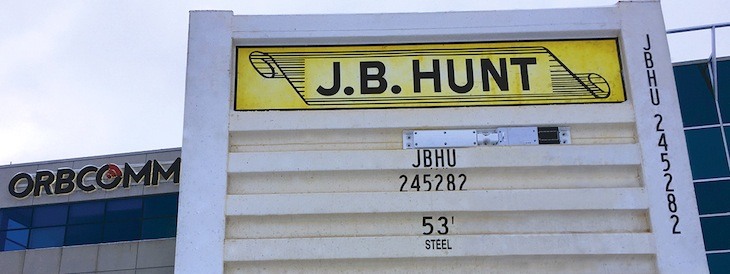Established logistics companies leading technology gains; analyst puts a ‘hold’ on J.B. Hunt
by June 8, 2018 11:44 am 762 views

Logistics companies generate the highest financial return across the transportation industry, and many of these companies are leaders in the development of technology and algorithms as startups look to enter the market and take market share from established companies.
But fears over the success of startups, at least in the short term, might be exaggerated, analysts said.
In a recent equity research report, transportation analysts Brandon Oglenski, Matthew Wisniewski and Matthew Preston, all of Barclays, explained the logistics sector provides “the best prospects for future growth within the broader transport universe.”
“But with high returns, limited asset requirements, fast growth and technology driven innovation, many investors fear today’s current logistics providers could be disintermediated by future ‘disruptive’ new software platforms that could gain significant market share from incumbents with much lower margins given limited asset requirements in the business.”
However, existing logistics companies, such as XPO Logistics, C.H. Robinson, Expeditors and Lowell-based J.B. Hunt Transport Services have been driving innovation in the sector and are developing and improving their systems, the analysts said. While not mentioned in the report, other Arkansas trucking and shipping companies like Fort Smith-based ArcBest and Van Buren-based USA Truck have logistics operations.
In a separate report, the analysts compared the margins of ridesharing company Uber to margins of established truck brokerage companies and found the margins were similar between Uber and the established companies. This suggested that startups might not soon take market share from established companies.
“Productivity is clearly higher for a ridesharing platform, but we note the business-to-business nature of the freight brokerage business requires significantly higher touch service compared to a consumer hailing a taxi,” according to the analysts. “Further, returns in the business are at or even about levels achieved over a decade ago, as incumbents leverage technology driven efficiencies.”
Yet, some companies such as XPO have gained market share from other large companies slower to grow. And, with larger companies leading technology advancements in the industry, fears over startups disrupting the industry might be exaggerated, according to Oglenski, Wisniewski and Preston.
A HOLD ON HUNT
For J.B. Hunt, strong freight demand should lead to robust earnings, but short-term costs, price increases that have been slow to come and projected low intermodal load growth have the analysts looking to large market capitalization carriers. Barclays gives hold rating on the carrier’s stock with a 12-month target price of $128.
In 2018, the company expects revenue to rise between 11%-15% and earnings to rise at a faster rate than revenue, according to a J.B. Hunt report by Oglenski. Historically, the company has focused on intermodal expansion, but Oglenski believes management is increasingly focused on expanding its dedicated trucking and brokerage segments.
Over the past 10 years, the Dedicated Contract Services and Integrated Capacity Solutions segments have grown to comprise of more than 38% of revenue and 31% of earnings for the carrier. Operating margins have declined as the carrier expands its asset-light brokerage business, and the performance of the intermodal segment has also put pressure on margins. This is likely a result of the company’s decision to increase market share in a weak environment. But operating margins in the brokerage segment, excluding payments to third-party carriers, look good, considering the limited assets that are needed for the business, Oglenski said. Operating margin is calculated by dividing operating income by revenue.
As a result of profitability challenges in J.B. Hunt’s core businesses, its returns have steadily declined over the past five years, according to Oglenski. But the intermodal segment continues to drive the largest rate of returns, and a price improvement with large rail partner Burlington Northern could strengthen the company in the future. In January 2017, the company started arbitration proceedings with Burlington Northern, likely showing that the company looks to increase its revenue share, which is split with the rail company. Previous negotiations took place in 2004 and 2005, but they didn’t lead to changes in J.B. Hunt’s business following the resolution in late 2005, Oglenski said. However, growth and profitability increased in the following two years.
In 2018, intermodal pricing is expected to rise, and J.B. Hunt’s intermodal business is closely tied to pricing in the sector. The intermodal segment accounts for 68% of the company’s operating income and 55% of revenue. In 2015 and early 2016, when the company expanded its intermodal business, it increased load volume but at lower yields. The expansion strategy should increase earnings as it negotiates for new contract prices in a strong freight environment, but for at least the first half of 2018, the gains will be more measured, he said.
The company has invested in its software platform, J.B. Hunt 360, after announcing a $500 million investment in technology over five years. Oglenski is unsure what to make of the system, but was impressed with what it could become. The plan is to provide a platform for U.S. freight movements and display nearly all shipper loads and carrier capacity.
“We suspect the company will monetize the platform with likely automated freight matching (brokerage) but further provide and increased product offering to its core customers from the asset-based business. Through leveraging software and data, we suspect J.B. Hunt’s goal is to further increase customer transportation share spend and further consolidate a still disparate business,” he said.
